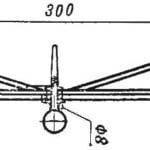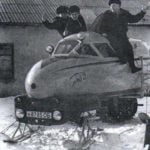 In this article I will try to tell about my attempt to make a water cooling system for CPU in the home. This will describe the highlights and technical details on my own experience. If you are interested in a detailed illustrated manual for the manufacture, Assembly and installation of such a system, it is welcome under the cat.
In this article I will try to tell about my attempt to make a water cooling system for CPU in the home. This will describe the highlights and technical details on my own experience. If you are interested in a detailed illustrated manual for the manufacture, Assembly and installation of such a system, it is welcome under the cat.
Video of the manufacturing process at the bottom.
The idea of creating more efficient cooling home computer I was born in the process of finding ways to improve the performance of your computer with the help of “overclocking” of the processor. Overclocked CPU consumes half as much power and heats up, respectively. The main restriction of buying ready – price, buy in the store ready-made water cooling system is unlikely to cost less than a hundred dollars. And in related budget liquid cooling systems are not particularly praised. So it was decided to make simple ITS own and with minimal costs.
Theory and Assembly
Basic details
- The water block (or heat exchanger)
- Centrifugal water pump (pump) with a capacity of 600 litres/h.
- Cooling radiator (automotive)
- Expansion tank for coolant (water)
- Hoses 10-12 mm;
- Fans with a diameter of 120mm (4 pieces)
- Power supply for fans
- Supplies
The waterblock
The main objective waterblock it’s fast to pick up heat from CPU and to transmit it to the coolant. For this purpose the most suitable copper. It is possible to manufacture the heat exchanger and aluminum, but its thermal conductivity (230Вт/(m*K)) is twice less of copper (395,4 W/(m*K)). Also important is the device water block (or heat exchanger). The device of the heat exchanger consists of one or more continuous channels extending through the internal space of the water block. It is important to maximize surface contact with water and avoid stagnation of water. To increase the surface usually use frequent cuts on the walls of the waterblock or establish small needle-like radiators.




I wasn’t trying to do something difficult, so began to do simple water container with two holes for tubes. The basis was taken brass connector for pipe, and the reason was the copper plate with a thickness of 2 mm. On top of the same plate are inserted two copper tubes of diameter of the hose. All sealed tin-lead solder. Making the waterblock more at first I did not think about his weight. Assembled with hoses and water on the motherboard will hang more than 300 grams, and for ease I had to use an additional attachment for hose.
Material: copper, brass
Diameter of fittings: 10 mm
Soldering: Tin-lead solders
Mounting method: screws to mount the store cooler, the hoses are fastened with clamps
Price: about 100 rubles
Sawing and soldering












Pump
Pumps are external or submersible. The first only passes it through itself, and second it pushes, being immersed in it. Here we have used the submersible is placed in a container of water. External could not find, searched the pet stores, and there is only submersible aquarium pump. Capacity is from 200 to 1400 liters per second price from 500 to 2000 rubles. Mains power 4 to 20 watt. On a hard surface pump is very noisy, and the foam noise negligible. As the water tank was used by the Bank holding the pump. To attach the silicone hose was used in steel clamps with screws. For easy putting on and taking off the hoses, you can use the grease without the smell.

Maximum capacity — 650 l/h.
The height of water rise to 80 cm
Voltage – 220V
Power – 6 Watts
Price — 580 rubles
Radiator
How much quality will be cooler, will largely determine the efficiency of the entire cooling system. There are used car radiocomsystema heating (stove) from nine, bought the old at a flea market for 100 rubles. Unfortunately, the interval between the plates it turned out to be less than a millimeter, so I had to manually push and compress the plate in several pieces to the weak Chinese fans were able to blow right through him.
Material tubes: copper
Material of ribs: aluminum
Size: 35х20х5 cm
Diameter of fittings: 14mm
Price: 100 roubles
Blowout
The radiator is blown by two pairs of 12 cm fans in front and back. To power 4 fans from the system unit during verification was not possible, so I had to build a simple power supply of 12 volts. The fans were connected in parallel and connected with the correct polarity. This is important, otherwise, most likely the fan can be spoil. The cooler 3 wires: black (ground), red (+12V) and yellow (speed).

Material: Chinese plastic
Diameter: 12 cm
Voltage: 12V
Current: 0.15 A
Price: 80*4 rubles
For the record
The purpose of the noise reduction I did not put because of the cost of the fans. So the fan for 100 roubles is made of black plastic and consumes 150 milliamps of current. The sort I used for radiator cooling, blowing weak, but cheap. Already for 200-300 rubles, you can find much more powerful and beautiful models with consumption of 300-600 milliampere, but at maximum speed they are noisy. This is solved with silicone gaskets and anti-vibration mountings, but for me the crucial importance played a minimal cost.
Power supply
If you are ready at hand, it is possible to collect the simplest of scrap materials and chips, costing less than 100 rubles. For 4 fans required current of 0.6 A and a little in reserve. The chip gives about 1 ampere at a voltage of 9 to 15 volts depending on the model. You can use any model, exposing a 12 volt variable resistor.



Tools and a soldering iron
Radio
Chip
Wire and insulation
Price: 100 roubles
Installation and testing of
Hardware
CPU: Intel Core i7 960 3.2 GHz / 4.3 GHz
Motherboard: ASUS Rampage 3 formula
Power supply: OCZ ZX1250W
Thermal grease: AL-3
Software
Windows 7 x64 SP1
Prime 95
RealTemp 3.69
Cpu-z 1.58


Very long test was not necessary, because the results were not even close to the capabilities of the air cooler. The radiator was blown so far only two Chinese fans from 4 possible and has not yet been spread apart wider than the plate for better venting. So to save energy and zero loading temperature of the processor on air approximately 42 degrees, and on self-made SVO 57 degrees. Run prime95 on 4 threads (50% load) warms to 65 degrees on air and to 100 degrees in 30 seconds!. Overclocking results even worse.
An attempt was made to make a new waterblock with a thin (0.5 mm) copper base plate and almost three times more spacious inside, though from the same materials (copper + brass). The radiator push plate for better venting and added two fans, they are now 4 pieces. This time in the power saving mode and zero loading temperature of the processor on air approximately 42 degrees, and on self-made SVO, about 55 degrees. Run prime95 on 4 threads (50% load) warms to 65 degrees on air and to 83 degrees on SVO. But the water in the loop pretty quickly starts to heat up and after 5-7 minutes the CPU temperature reaches 96 degrees. This testimony without overclocking.



Collect ITS was certainly interesting, but to apply it to cool a modern CPU has failed. In older computers copes regular cooler. Maybe I picked up poor quality materials or improperly manufactured waterblock, but to collect ITS less than 1000 rubles, and at home I is not possible. After reading the related budget ready ITS available in stores I didn’t hope that my homemade is better than a good air cooler. For myself concluded that it is not necessary to save in the future components for the SVO. When you decide to buy water cooling system for overclocking, definitely going to collect it myself from individual parts.
I hope to read and watch was interesting.
Atideo:



